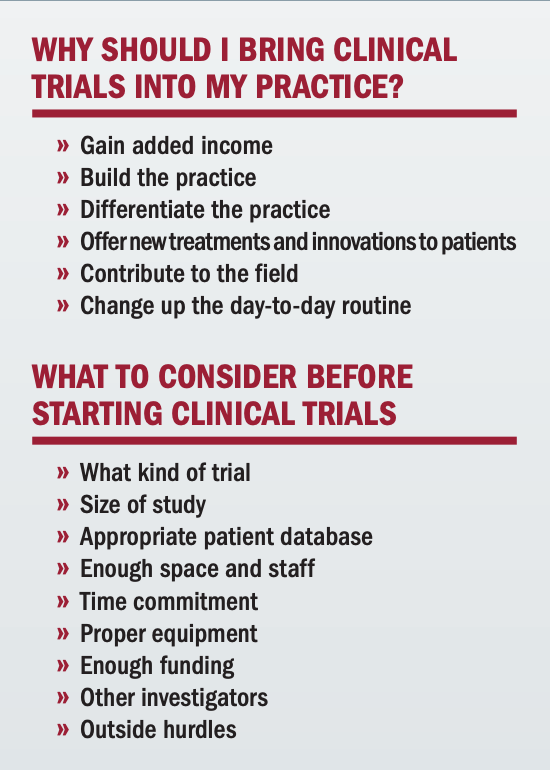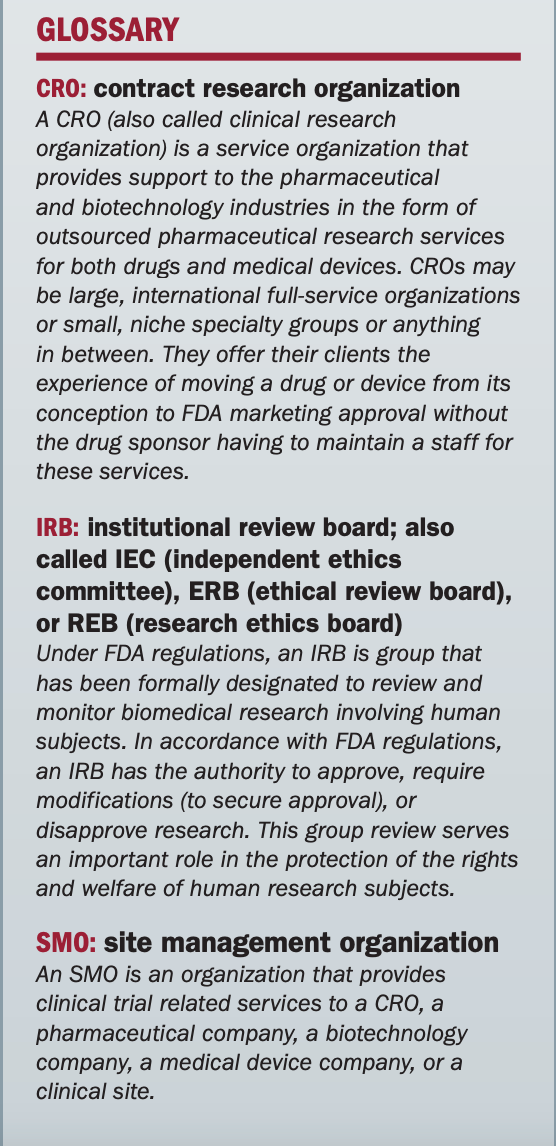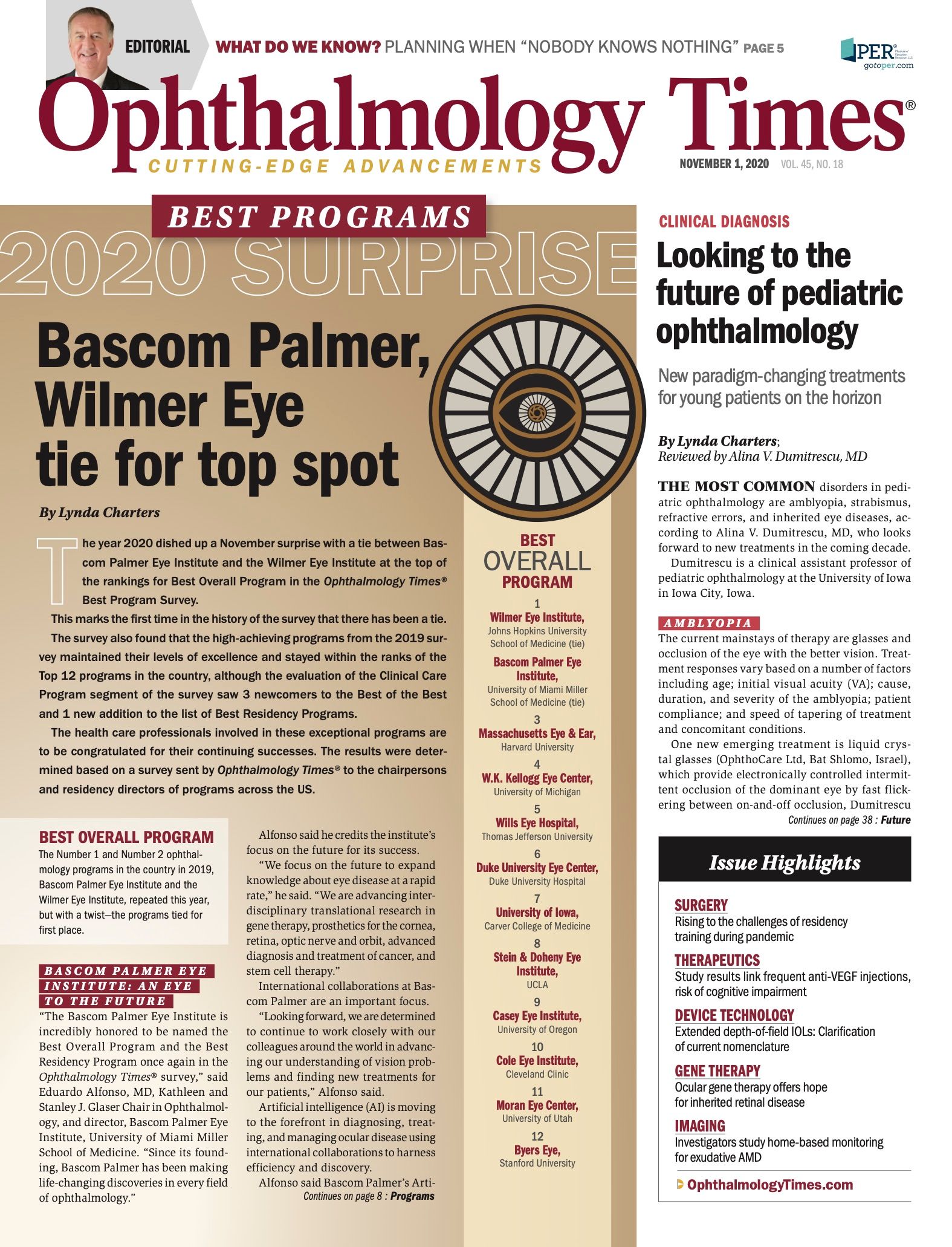Publication
Article
Digital Edition
Increasing your practice’s reach, relevance, and revenue with clinical trials
Author(s):
Working as an investigator can prove to be a positive experience for physicians


Special to Ophthalmology Times®
Choosing to be an investigator for clinical trials can be a rewarding experience for practices both professionally and financially.
As a clinical trial site, you are offering participants—who are often underserved—an opportunity to benefit from a promising treatment they would not otherwise have received.
Involved providers and patients can feel fulfilled knowing they are playing a crucial role in the development of a potential new therapy or device that may benefit others and the eye-care field.
Being a clinical trial site requires considering many factors to ensure it is a right fit for you and your practice. Below is a discussion of what it takes to be a successful site and investigator, as well as the why, who, how, and when.
Related: (AAO) Applying impact of real-world data on day-to-day practice
The why

A motivating force behind incorporating clinical trials into a practice is the ability to bring in additional revenue. Eye-care practices have suffered adverse consequences in terms of the bottom line during the coronavirus disease 2019 (COVID-19) epidemic.
Between income lost during the shutdown and now potentially decreased patient volume due to safety measures such as social distancing and spacing out appointments, the pandemic will continue to take its toll financially.
The now common phrase “these uncertain and challenging times” speaks loudly to the need for practices to seek alternate and creative ways to remain financially stable.
Being a clinical trial site brings in additional revenue that is separate from the day-to-day business of caring for patients. Being paid through an outside sponsor or contract research organization (CRO) is a known quantity.
Related: Electronic health records: Moving beyond 'just a requirement'
As an investigator, you can depend on a specific source of income—a rare sure thing.
This means you have more control over patient reimbursement, which works out to be a higher monetary return per patient encounter than can be obtained through third-party insurance reimbursement.
Because you know the exact amount of income, you have more control over your profit margin. Another benefit is the ability to exert more control over the utilization of chair time. More control and fewer uncertainties are 2 key aspects of clinical trial participation.
As a clinical trial site, you will interact with new patients, ones who may not otherwise have come to your practice. This is an opportunity to add to your patient base and build your practice.
Being an investigator can also provide you with enhanced credibility and an edge over your competition. It may set your practice apart by offering a novel treatment or technology.
Being an investigative site also is a great way for you to contribute to the knowledge base in ophthalmic research, as well as boost the eye care industry. It is gratifying to help bring a promising new treatment or technology closer to reality for improving patient care.
At the same time, seeing more varied patient types can take you out of established patterns, spark renewed interest, and pique your curiosity. Being an investigator can be personally reinvigorating and act as a reset.
Related: Big data drives opportunity for real-world evidence
The what
Before you start, take your time evaluating what is involved in being a clinical investigation site. Here are some important practical and logistical questions to ask:
> What kind of trials do I want to do? What types of treatments or technologies do I want to study?
> How many patients would I need to enroll and complete to achieve clinically significant findings?
> Is my patient database large enough to accomplish my goal, or will I need to recruit outside patients?
> Do I have the space and staff to properly participate? This includes enough exam lanes for efficient patient flow, a waiting area large enough to accommodate participating patients, and sufficient staff and technicians to handle the planned patient volume.
> Do I have enough time in my schedule? Am I willing to work longer hours and/or weekends?
> Do I have the proper technology/equipment needed?
When it comes to the financial aspect, think seriously about whether participating is worth it. You need to decide if you will receive proper funding for your time.
Related: Clinical trial outcomes for macular edema don’t translate to ‘real-world’ settings

But you also must consider if the amount is enough to cover the expenses associated with additional staff time, overhead, and any materials or equipment that may be needed.
Another factor that should play a part in the decision-making process is the number of investigators required. Perhaps you have partners and associates who can share the workload.
Take note of any outside hurdles that may be in place, such as the location and accessibility of your practice and the cultural diversity of your patient population.
For example, are there any cultural barriers in your community that would make conducting clinical trials or recruiting participants prohibitive?
Keep in mind that participants are compensated for their time, therefore the income level of your population is a considerable factor.
As clinical investigators who frequently collaborate with Ora, a CRO group specializing in ophthalmic product development, our practices regularly conduct dry eye and ocular allergy studies.
Related: Examining ocular allergy, quality of life
Environmental variables such as climate and weather can have an impact on patients’ characteristics and the data being gathered in these types of trials.
The who
To start, you need a sponsor or supporter. The most common source of funding comes from a pharmaceutical, device, or contact lens manufacturer. Typically, as a clinical investigator and trial site, you will be working with a CRO.
These organizations provide support to the pharmaceutical, biotechnology, and medical device industries in the form of research services outsourced on a contract basis.
Ora is a full-service global CRO dedicated to ophthalmology, with an expert approach to clinical trial operations. Ora assists with on-site support staff who are carefully trained, and these teams work closely with our staff to ensure high quality protocols that lead to successfully implemented studies.
Another group involved in helping to run clinical trials is a site management organization (SMO). An SMO’s function is to provide clinical trial-related services to a CRO, a pharmaceutical company, a biotechnology company, a medical device company, or a clinical site.
Related: Retinal implant improves quality of life in patients with RP
The how
All clinical trials require the development of a protocol based around the goal, purpose, or hypothesis of the study. The clinical trial may be phase 1, 2, or 3 depending on how far along the study treatment is in development. A phase 4 study takes place after approval and is also known as postmarketing surveillance trial.
There also are several options to consider when selecting a trial.
The trial type must be chosen: masked or unmasked, crossover or noncrossover, randomized or nonrandomized. You will need to gather references to support the protocol chosen and submit it for regulatory approval to ensure the trial meets appropriate conduct and guidelines.
To be considered for publication, cliniclal trials must be approved by an institutional review board (IRB)—sometimes referred to as an independent ethics committee (IEC), ethical review board (ERB), or research ethics board (REB).
The sponsor must sign off on the trial, and, in some cases, the local community may need to grant approval as well.
Related: Phase 3 trial kicks off for glaucoma candidate
Recruitment, preparation
A combination of tactics is used to find participants, such as mining the practice’s database and leveraging advertising, referrals, and other practices. When we work with Ora, we will rely on the company’s team to create multichannel advertising campaigns to ensure we reach our enrollment targets.
Recruiting and retaining participants can be challenging, so Ora uses a block enrollment process to schedule a group of study patients before the trial start date. This method helps speed up and support our patient enrollment, and keeps things progressing.
Other CROs typically use the conventional rolling enrollment strategy, meaning you qualify and accept patients on an ongoing basis. This can take more time, which may lead to unpredictable income.
To prepare for the kickoff of the trial, you will need to obtain the necessary equipment and supplies, determine the best patient flow for efficiency, and train your staff.
Conducting trials
The procedures you perform for the study will not be substantively different from those in your daily clinic. You need to make sure every staff member knows his or her assigned tasks and that they facilitate a smooth and efficient flow.
Related: Study: Patients at moderate risk of ectasia stable 2 years after treatment
It is important to note that stressed subjects are unhappy subjects, and unhappy subjects reflect poorly on you and your practice, not to mention they could be dissuaded from future participation.
Records and documentation are a key component to any successful clinical trial. Meticulous documentation of patient encounters is critical, whether it be in the chart, a separate source document, a case report form, or some combination. Problems can arise, such as patients not completing all required visits or having adverse events. Time restrictions also can come into play, complicating your ability to perform all of the necessary procedures.
After trial
Once the last patient visit has been recorded, you will collect and submit the data to the sponsor. Data can be analyzed internally, or you may farm this out to a professional statistician.
The data and outcomes can then be made public through presentations at large meetings, either in poster or paper format; an article in a peer-reviewed journal; or in marketing materials used by the sponsoring company.
If the trial was a success, and your experience was a positive one, consider continuing to build your database for future participation and recruiting proactively. The clinical findings may spur ideas for other investigations and heighten your desire to stay involved with trials.
Related: Improve patient comfort with intravitreal injections
Conclusion
If being a site and investigator for clinical trials is a good fit for you and your practice, the benefits are numerous. Beyond increased, reliable income, your practice also can be seen as offering exciting advancements in your community.
It gives you the chance to try new therapies and technologies, and it’s a meaningful way to contribute to the eye care field. A bonus is that you can reenergize yourself and find new enthusiasm for what you do every day.
Although the initial investment and steps required to set up a study site can be intensive, the proper planning and careful consideration will pay dividends in the long run. Bringing clinical trials to your practice rewards you, your patients, and the field. In other words, the “when” is now.
About the authors
Jason R. Chin, OD, FAAO
e: jasonchinod@gmail.com
Chin is in practice at Andover Eye, Andover, Massachusetts.
Gary W. Jerkins, MD
e: drjeyeguy@garyjerkins.com
Jerkins is president/principal investigator at Advancing Vision Research, LLC, in the greater Nashville, Tennessee, area.

Newsletter
Don’t miss out—get Ophthalmology Times updates on the latest clinical advancements and expert interviews, straight to your inbox.




